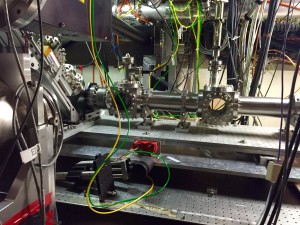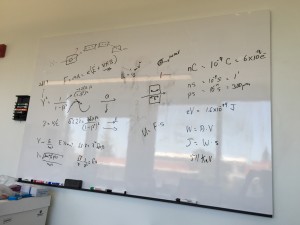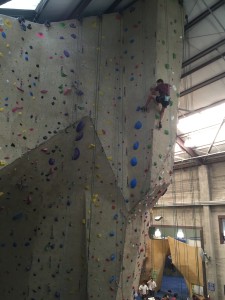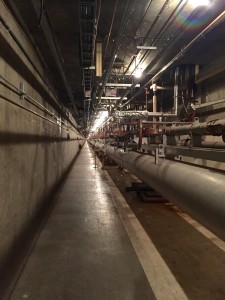Hi, I’m Jack Plantz. This summer I am participating in an internship at SLAC, the Stanford Linear Accelerator Center in Menlo Park, California. I’m working with my mentor, Tor Raubenheimer, to study and improve the performance of SLAC’s free-electron laser. SLAC is a facility operated by Stanford University for the Department of Energy to study particles at high energies and relativistic speeds. The main linear accelerator (linac) is 3 kilometers long and accelerates electrons to .999999 times the speed of light.

A plasma chamber in the accelerator
I flew into San Francisco last Saturday night and had dinner with Melody and Charlie Stevens, friends of ours who used to live in Telluride. The next day we drove out to Menlo Park to meet the family I’m staying with, the Gershenbergs. Their house is only half a mile from SLAC and within easy biking distance. They have a 17-year-old son named Marcus who is on the football team at the local high school and at 15-year old-daughter, Taya. Their whole family is actually on vacation in Italy for the next two weeks so I’m here at the house without them for the first part of my internship. All I need to do is feed and walk their dog Lucy. Marcus also introduced me to a bunch of his friends before he left so I have some people my age to hang out with.
When I got to SLAC, my crazy learning curve started. This week I’ve been getting up to speed on the physics of the accelerator, special relativity and the math that goes with it. Tor explained how the accelerator works and how it’s used to create an X-ray laser. Then he gave me some practice problems to work on to get a feel for the concepts. There were only six problems, but in order to answer them I had to learn about entirely new physics concepts including electric and magnetic fields, beam dynamics, magnetic focusing, relativistic time dilation and relativistic length contraction. Tor gave me a paper to read that explained the physics at work in the accelerator, but it was intended as a graduate level textbook and I had no idea what most of the words even meant. I went on wikipedia to figure it out, but for every wikipedia page I’d have to click on almost every blue link to understand what that page was saying, then more links to figure out that page, and so on. (google “Maxwell’s Equations” and you’ll see what I mean.)
I’ve never absorbed so much information so fast in my life. But I did eventually get an understanding of what the textbook was saying. Also, to solve the problems, I had to use all the math I learned from two years of calculus, even things I thought I’d never use, like infinite series. I asked Tor for help whenever I got confused (which was a lot) and now I feel like I have a working idea of what’s going on in the beam.

The whiteboard in Tor’s office covered in crazy physics
So, from what I’ve learned, here’s the short version of what’s happening in the accelerator:
At the start of the two-mile-long tunnel is the electron gun. High energy lasers are focused on a piece of metal which frees electrons from its surface. These electrons are then accelerated down the tunnel in a vacuum chamber using microwaves. The microwaves oscillate back and forth at a very high rate, but the electrons are released only in short ‘bunches’ so that they always encounter the part of the microwave that accelerates them forward instead of pushing them back. Each bunch has about 1 billion electrons. After only a few meters, the electrons are traveling essentially the speed of light, about .99c. But because nothing with mass can travel faster than the speed of light (c), when the accelerator gives the particles more and more energy, instead of going faster they actually gain more mass. This is the effect that Einstein’s famous equation E=mc2 describes. SLAC’s accelerator operates at energies around 10 GeV (billion electron volts) which means the electrons being accelerated have about 20,000 times more mass than they do at rest and are traveling at about .999999c.
After the electrons are accelerated to high energy, they are put through a magnetic wiggler that deflects them side to side. Electrons emit x-ray radiation at the wavelength they are wiggled at. The magnets in the wiggler are spaced 3 cm apart but because of length contraction due to Special Relativity, they appear to the particles to be 20,000 times closer together. Then when we look at the radiation from our non-moving reference frame, it looks another 20,000 times shorter. So the radiation that is actually produced has a wavelength of about an angstrom, the width of an atom. Special Relativity is kinda crazy.
This X-ray laser is called the LCLS (Linear Coherent Light Source). It’s incredibly high frequency X-rays can be used to take pictures of chemical reactions and complex proteins at the atomic scale. This technique is very valuable for research in lots of different fields. Understanding these reactions at such a small scale can lead to huge breakthroughs in medicine, biology, materials sciences and cancer research.
Tor is actually leading the design of a new free electron laser, LCLS 2, that will be built in the same tunnel and is scheduled to turn on in 2020. So for me to be able to work with the accelerators that are here right now, I’m working with Tor’s colleagues, Juhao Wu and his team, to improve the coherence of the X-rays in the LCLS so that they stay in phase with each other and build on each other to get to higher power output. There’s a whole other explanation for how they’re going to do that but I’ll save that for the next blog.
On Thursday I got to go down and tour the accelerator tunnel. The LCLS beam is turned on right now so no one can go into it because of the radiation, but I got to go into a different section of the accelerator called FACET, which stands for Facility for Advanced Accelerator Experimental Tests. (I know, it’s silly that the acronym doesn’t actually have the same letters but FACET sounds way cooler than FAAET).
The linac is cut into two sections right now to do two different experiments. The LCLS uses 2000 meters of the accelerator and the other 1000 meters used for FACET to study a new technique for building accelerators called plasma wakefield acceleration that will be thousands of times more powerful than conventional accelerators. The test plasma section in FACET doubles the energy of the 1000 meter accelerator in only 2 meters.
Anyway, that 1000- meter section is turned off right now so I got to go down there into the tunnel with a team that’s doing research in it. Looking down the tunnel is really cool because it’s perfectly straight and everything in your field of view goes towards the one vanishing point at the end of the tunnel. It’s like being in a one point perspective drawing. It’s also a funny transition between the old copper accelerator that is over 50 years old and FACET’s brand new shiny plasma chamber with laser optics all around it. But even though the copper accelerator looks old, on the inside it’s still perfectly clean because it has been kept in a vacuum state for the entire 50 years.
But I’m also having a great time outside of SLAC. Tor is an avid climber and he’s taken me with him to the climbing gyms in Belmont and Sunnyvale a few times this week which was super fun. I’m getting better at the super overhanging style of climbing. He also has a 16-year-old daughter named Cade who is a competitive climber. I did a bouldering grip strength workout with her climbing team and it killed my forearms for the whole next day. I’ve also been out running a lot, mostly at night to avoid the heat. I went for one run in the afternoon and it was so hot out I felt like I sweated out my entire body weight in water. Also it didn’t help that I got totally lost and had to use my phone map to find my way back to my house. But all in all I’m having a great time here and I want to thank Pinhead for this awesome opportunity.

My mentor, Tor Raubenheimer at the Planet Granite climbing gym


Great report Jack! Sounds like you’re working on physics for an alternate universe. I’m so glad you’re getting the opportunity to meet and work with so many innovative people that can put complicated theory in to real world practical applications. Very cool!
ooxooMom
WHAT? I know you were putting all that complicated math and physics in layman’s terms, but the only part I understood was the “got lost and had to use my map app.” What an awesome experience for you! We will miss you this week, but I see this is an incredible opportunity for you! Have fun.
I have no earthy idea of what you are taking about but it sounds fascinating. What an awesome opportunity.
BTW, can I get in the wiggler section to lose a few pounds. Just wondering?
Wishing you the best in your our suit of acceleration excellence,
Uncle Greg
Thanks for sharing your adventure. Well written, one can visualize your experience and what a unique experience that appears to be. Thanks Jack.
Nice work Slac’r!
Hey Jack….Aunt Gail here. So it’s painfully obvious to me that I don’t know anything at all re. physics and I very much appreciated your detailed blog. Jed gets it and loved it! Very good you took the opportunity to learn, to travel and to meet some amazing mentors. Keep it up.